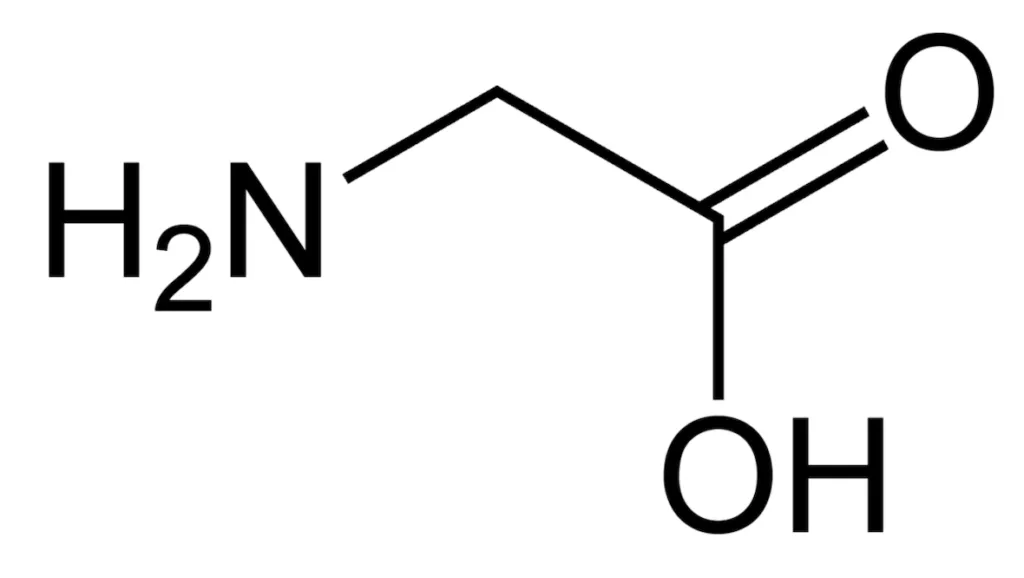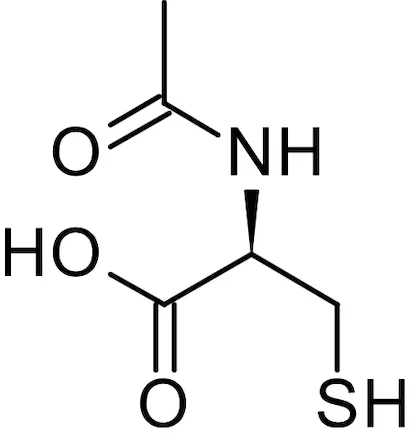What is Glycine?
Glycine, often sold in form of Glycine Powder, is the latest craze among anti-aging enthusiast. And for a good reason, or better to say, “reasons”, as there are so many of them. In this article, I will explain everything (including Glutathione, Collagen, N-Acetyl Cysteine and Methionine), but don’t worry, I will keep it concise.
What is important for you is that Glycine works, is cheap, and is very easy to supplement (unlike other expensive products with dubious or none effects – looking at you, Resveratrol)

Glycine is the smallest amino acid, with just a hydrogen atom as its side chain. Its chemical formula is C₂H₅NO₂ and it is non-essential, meaning the body can produce it on its own, and it is also obtained through the diet. However, the body can only make around 3 grams of Glycine per day, and that is not enough.
You can also get Glycine from high-protein foods such as meat, fish, dairy products, legumes, etc. It is estimated that you can get around 2-3g of Glycine from food, so with the 3g that your body can synthesise, we are at 6g of Glycine per day. The reason you need more is tied to Collagen.
This article is not health or medical advice. Please contact your physician before trying anything described in this article.Table of Contents
Why Collagen and Glycine?

You’ve probably heard about the benefits of Collagen for skin and joints. Your skin’s Collagen decreases by about 10% per year since the age of 20. That means at 70 years old, you might have lost as much as half of your skin’s collagen – and we don’t want that.
The human body needs Glycine for Collagen turnover, and it has been estimated at least 12g of Glycine per day is required (with some estimates going as high as 36g/day, so 12g is on the low end).
But you also need Glycine for other processes:
- Collagen synthesis
- Creatin synthesis
- Production of heme (part of hemoglobin in blood cells)
- Glycine is a neurotransmitter and promotes sleep/reduce anxiety
- Glutathione synthesis (see below)
Those marked in bold are estimated to require another 3g of Glycine, so WE ARE AT 15g NOW.
You can supplement Collagen directly in the form of Collagen Peptides, and I do so. Not only is Collagen great for skin and joint health (it has been proven in many human studies to improve hallmarks of skin aging), but your body can also get some Glycine from it as well (from 10g of Collagen, your body can get 3g of Glycine).
Wait a minute. So should I take Glycine to make Collagen (and other things) from it, or should I take Collagen to have directly Collagen and make also some Glycine from it? Well, the answer is both. You want to have enough or both so your body can use or make whatever it need in a given moment.
Glutathione and NAC (N-Acetyl Cysteine)
Glutathione supports overall health by acting as a powerful antioxidant, aiding in detoxification, boosting the immune system, and promoting cellular repair. This is essential for anti-aging, and it has been shown that centenarians have statistically higher levels of Glutathione [5].
Glutathione is a tripeptide made from 3 amino acids:
- Glycine
- Glutamic Acid
- Cysteine

From those 3, Glycine and Cysteine levels decrease during aging. So, given the benefits of Glycine, we should also add NAC (N-Acetyl Cysteine) as a good source of Cysteine.
The benefits of taking Glycine + N-Acetyl Cysteine:
- Improves glutathione deficiency
- Improves mitochondrial function
- Lowers inflammation
- Improves muscle strength
- Increase exercise capacity
- Lowers genomic damage
- Improves body composition
- Lowers insulin resistance
- Lowers endothelial dysfunction
- Improves cognition
- Lowers oxidative stress
- Reduced blood pressure
- Improved markers of cellular senescence
- Improved markers of mitophagy and stem cells

What dose of NAC (N-Acetyl Cysteine) should one take? We know that to cover Glycine body requirement of 15g, we need around 10g of Glycine per day, as our body makes 3g, and we get 2-3g from food during the day.
With NAC, the situation is not so simple, and it also depends on your age and liver health. Young people under 45 years of age do not seem to need large amounts of NAC daily (they might try it to boost their immune system occasionally). However, older people might start with up to 4 months course of 100mg/1kg of body weight of both Glycine and NAC and then lower the dose.
If you are younger than 45 years, your body levels of Glutathione are likely good. The decline starts later in life and differs person to person. It might be wasted money to add NAC, but definitely keep Collagen and Glycine.
There is a bit of caution, though, as NAC was shown to actually reduce lifespan in simpler organisms [4]. All the latest hype is mainly from the GlyNAC study [1], and there are opinions that Glycine actually did all the heavy lifting in that study. Some people also take Glutathione directly instead of Glycine and N-Acetyl Cysteine (Glutathione supplement is bit expensive though).
I am experimenting with 500mg of NAC for two months (lowered from 1g), and after that period, I will stick to just Glycine and Collagen – but I am 39 years old (young), keep that in mind.
But if I were 70 years or older, I would try full dose of NAC+Glycine for 4 months as in the GlyNAC study [1].
As always, do your own research and see the disclaimer at the top of this article.
Glycine Powder vs. Methionine
Ok, I know this is getting little bit long; it seems like Glycine plays role in lot of body processes, and indeed it does. We are coming to an end, however.
Methionine is an essential amino acid, which means our body can’t make it but need to get it from food. There is no shortage of Methionine, as it is present in the same food sources as Glycine (meat, fish, dairy, eggs, legumes, etc.)
It is known from animal experiments that Methionine restriction increases lifespan and slows down aging. Also, excess Methionine raises Homocysteine levels, which are linked to aging and cardiovascular disease.
Methionine restriction is not an easy task, as plenty of food contains Methionine. Luckily for us, it has been shown that taking Glycine can offset the bad effects of Methionine [8]. For every gram of Methionine, you need 0.5 to 1g of Glycine, so if you eat diet very high in meat, you should increase your Glycine even more.
Side Effects of Glycine
Side effects are very rare; a few people have reported nausea, vomiting, and an upset stomach after taking Glycine Powder or capsules. It also lowers blood sugar, which can lead to hypoglycemia. Are you serious? Glycine can also lower my blood sugar?
Well, yes, although the mechanism is still not entirely clear, Glycine is doing that indirectly, but it is measurable and effective [6]. It is also an additional argument to consume Glycine after the biggest meal of the day, which might cause a spike in blood sugar. Glycine helps with that (and offsets the negative effects of Methionine) + does all the other good things described in this brief article and perhaps much more.
My Anti-Aging Glycine Stack
To fully reap the benefits of Glycine, I am taking this:
After lunch (additional benefit of balancing Methionine undesirable effects and lowering blood sugar spike):
- 15g Collagen Peptides
- 3g Glycine Powder
- 250mg Vitamin C (helps with Collagen absorption)
- 15mg Zinc Chelate
And this 1 hour before sleep (as neurotransmitter, Glycine helps profoundly with falling asleep and sleep quality):
- 3g Glycine Powder
- 500mg NAC (N-Acetyl Cysteine) – for one more month as test, then I quit, given my age it seems not necessary
- 500mg Magnesium Chelate (further sleep enhancement)
- 100mg Vitamin C
What surprised me initially is how cheap Glycine Powder is (I paid 10,35 USD equivalent for a whole 1kg), and that it is sweet (unlike other amino acids which could be pretty bitter, for example, BCAA). Siim Land even mentioned he is using Glycine to sweeten his tea, which opens another way of using it. If you are not a fan of mixing Glycine Powder in water, you can also get it in capsule form, but it is a bit more expensive.

So I get 6g of Glycine directly in form of Glycine Powder, 4.5g of Glycine from Collagen Peptides, 2-3g from food, and my body can make another 3g. That should give me 16.5g of Glycine which should cover the 15g daily minimum requirement. Am I taking too much/too little/just right? Feel free to comment with your reasoning below this article!
Also, there is recent study (October 2023) showing the benefits of taking 30g of Collagen Peptides compared to 15, I will just leave it here for you to read [7].
You can see my complete supplement regiment here
Good Videos about Glycine
For more information about Glycine, watch this video by Siim Land; it is really good.
And this one by Mike Lustgarten is about Glycine and NAC:
References
[1] GlyNAC study
Kumar P, Liu C, Suliburk J, Hsu JW, Muthupillai R, Jahoor F, Minard CG, Taffet GE, Sekhar RV. Supplementing Glycine and N-Acetylcysteine (GlyNAC) in Older Adults Improves Glutathione Deficiency, Oxidative Stress, Mitochondrial Dysfunction, Inflammation, Physical Function, and Aging Hallmarks: A Randomized Clinical Trial. J Gerontol A Biol Sci Med Sci. 2023 Jan 26;78(1):75-89. doi: 10.1093/gerona/glac135. PMID: 35975308; PMCID: PMC9879756.[2] GlyNAC in Mice
Kumar P, Osahon OW, Sekhar RV. GlyNAC (Glycine and N-Acetylcysteine) Supplementation in Mice Increases Length of Life by Correcting Glutathione Deficiency, Oxidative Stress, Mitochondrial Dysfunction, Abnormalities in Mitophagy and Nutrient Sensing, and Genomic Damage. Nutrients. 2022 Mar 7;14(5):1114. doi: 10.3390/nu14051114. PMID: 35268089; PMCID: PMC8912885.Kumar P, Liu C, Hsu JW, Chacko S, Minard C, Jahoor F, Sekhar RV. Glycine and N-acetylcysteine (GlyNAC) supplementation in older adults improves glutathione deficiency, oxidative stress, mitochondrial dysfunction, inflammation, insulin resistance, endothelial dysfunction, genotoxicity, muscle strength, and cognition: Results of a pilot clinical trial. Clin Transl Med. 2021 Mar;11(3):e372. doi: 10.1002/ctm2.372. PMID: 33783984; PMCID: PMC8002905.[4] NAC effect on insect lifespan
Shaposhnikov MV, Zemskaya NV, Koval LA, Schegoleva EV, Zhavoronkov A, Moskalev AA. Effects of N-acetyl-L-cysteine on lifespan, locomotor activity and stress-resistance of 3 Drosophila species with different lifespans. Aging (Albany NY). 2018 Sep 20;10(9):2428-2458. doi: 10.18632/aging.101561. PMID: 30243020; PMCID: PMC6188487.[5]Glutathione statistically higher in centenarians
Xu, Q., Wu, C., Zhu, Q. et al. Metagenomic and metabolomic remodeling in nonagenarians and centenarians and its association with genetic and socioeconomic factors. Nat Aging 2, 438–452 (2022)[6]Glycine lowering blood sugar
Gannon MC, Nuttall JA, Nuttall FQ. The metabolic response to ingested glycine. Am J Clin Nutr. 2002 Dec;76(6):1302-7. doi: 10.1093/ajcn/76.6.1302. PMID: 12450897.[7] 30g of Collagen better than 15g?
Lee, Joonsung & Tang, Jonathan & Dutton, John & Dunn, Rachel & Fraser, William & Enright, Kevin & Clark, Dave & Stewart, Claire & Erskine, Robert. (2023). The collagen synthesis response to an acute bout of resistance exercise is greater when ingesting 30 g versus 15 g and 0 g hydrolyzed collagen in resistance-trained young men. Journal of Nutrition. [8] Glycine offsetting Methionine effects in rats
Sugiyama K, Kushima Y, Muramatsu K. Effect of dietary glycine on methionine metabolism in rats fed a high-methionine diet. J Nutr Sci Vitaminol (Tokyo). 1987 Jun;33(3):195-205. doi: 10.3177/jnsv.33.195. PMID: 3668700.Can Glycine Powder add 20+ years of great life? by cancel-aging

Leave a Reply